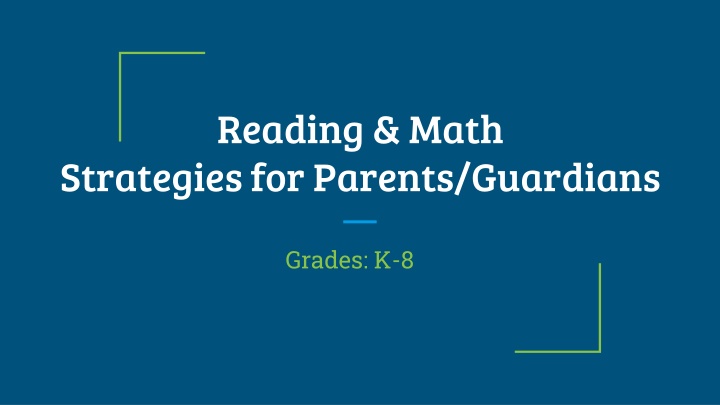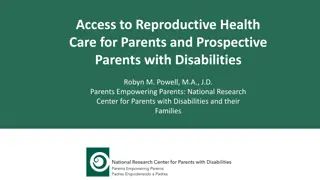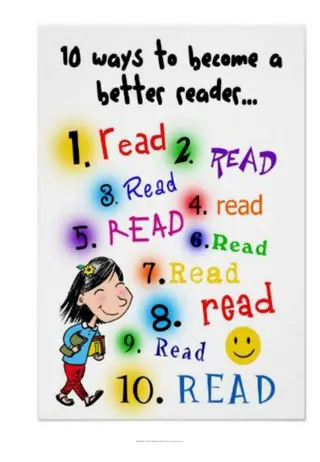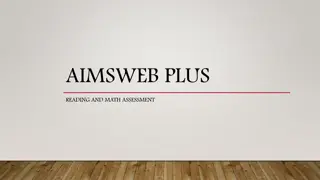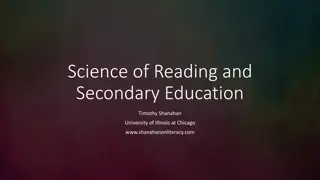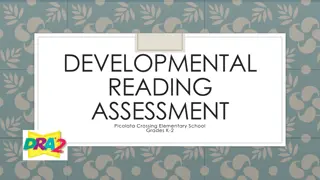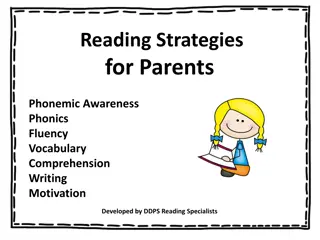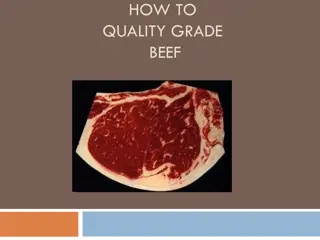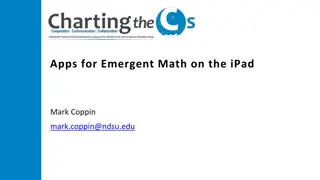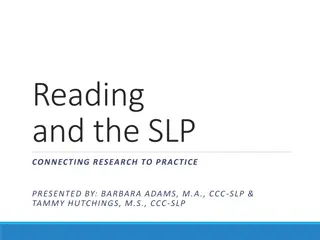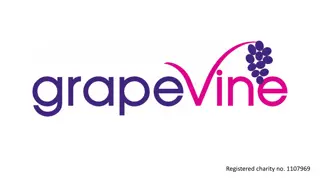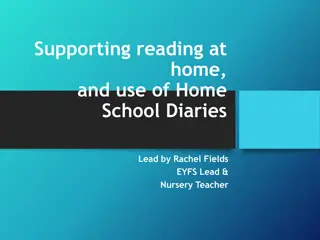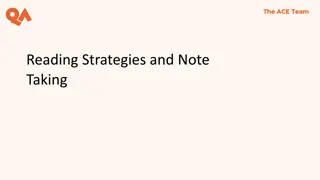Reading & Math Strategies for Parents/Guardians (Grades K-8)
Empower parents/guardians with effective reading and math strategies for students in grades K-8. Discover practical tips such as setting aside designated reading time, making reading part of daily life, and engaging in before, during, and after reading strategies to enhance children's skills. Explore free reading resources and top recommended educational websites for additional support.
Download Presentation

Please find below an Image/Link to download the presentation.
The content on the website is provided AS IS for your information and personal use only. It may not be sold, licensed, or shared on other websites without obtaining consent from the author.If you encounter any issues during the download, it is possible that the publisher has removed the file from their server.
You are allowed to download the files provided on this website for personal or commercial use, subject to the condition that they are used lawfully. All files are the property of their respective owners.
The content on the website is provided AS IS for your information and personal use only. It may not be sold, licensed, or shared on other websites without obtaining consent from the author.
E N D
Presentation Transcript
Reading & Math Strategies for Parents/Guardians Grades: K-8
We dont give homework, but there are strategies that you could be doing with your child at home to help them improve their reading and math skills.
Parental Support is Key to Success: 1. Model a positive reading experience. 1. Set aside designated reading-together time. 1. Fill your home with books. 1. Support and encourage the learning process. 1. Make reading part of daily life.
Basic Reading Strategies: -Read with your child or have your child read for 20 minutes every day. -Reread to help with decoding (sounding out words). -Read things that are not books to help build fluency. -Read aloud to help build vocabulary. -Tell your own made up story to help build working memory, attentiveness, and ability to think about different things one after another.
Before, During, & After Reading Strategies: Have your child make predictions about what the reading is going to be about. Before: During: Discuss characteristics of characters, Discuss setting of story Attempt sounding out hard words Look up definitions of words you don t know the meaning of. Ask your child questions that require them to recall what they read. Who, What, When, Where, Why, How type questions. After:
Free Reading Resources -Epic.com: books for all levels. Even has Read to Me books -OverDrive: (app for IPhone) you can download books from library -Storylineonline.net: books read aloud by famous people -Storyberries.com: Fairy tales, bedtime stories, and poems
Top Recommended Resources (Free & Pay) 1. ABCya! - http://abcya.com 2. Starfall - http://starfall.com 3. Storynory - http://www.storynory.com 4. Oxford Owl - http://www.oxfordowl.co.uk 5. Storyline Online - http://www.storylineonline.net 6. National Geographic Young Explorers http://ngexplorer.cengage.com/ngyoungexplorer/index.html 7. FunBrain - https://www.funbrain.com/books 8. International Children s Digital Library - http://en.childrenslibrary.org/ 9. PBS Reading Games - https://pbskids.org/games/reading/ 10. ReadThinkWrite - http://www.readwritethink.org/parent-afterschool-resources/
Math Strategies: -Practice basic math facts (+,-, x, ) for 10 minutes every day. -Connect math to everyday life. -Play card & board games together. -Grocery shopping
Math Resources: -https://toytheater.com/category/math-games/ -https://www.mathplayground.com/ -https://tangmath.com/games
Math Board Games: -Hi, Ho Cherry-O -Uno -Yahtzee -Trouble -Monopoly -Dominoes -Cards
Everyday Math at the store -Look at ads and compare deals and look for coupons -As you shop use a calculator to keep track of how much you spent -Give a handful of change to count our to pay for small purchases at the store -Ask child to compare prices at the store -Weigh fresh produce at the store and calculate price -Sort groceries as you put them away
Everyday Math at home -Fold napkins into different shapes -Measure ingredients for a recipe -Create a map of the house or neighborhood -Watch the weather and graph temperatures -Verbal math problems -Track scores of games played by favorite sports teams
Childrens Math Literature Resources: Counting & Numbers: One Hungry Monster, Tacky the Penguin, Ten Potatoes in a Pot Large Numbers: A Million Fish More or Less, The Wolf s Chicken Stew, How Much is a Million Problem Solving: Caps for Sale, Ten Apples Up on Top, Counting on Frank Graphing: Stone Soup, A Three Day Hat Geometry: The Greedy Triangle, Let s Fly a Kite, A Cloak for the Dreamer Time: Pig s on a Blanket, The Little Red Hen, Sunday Morning
Title 1 -Addresses academic needs of all students. -Instructional strategies are developed to help with academic success. The strategies are engaging & align with state standards. -Staff receives training to improve instruction & behavior. -As a Title 1 school we still have to administer state tests along with district assessments, diagnostic assessments, and classroom based assessments.
